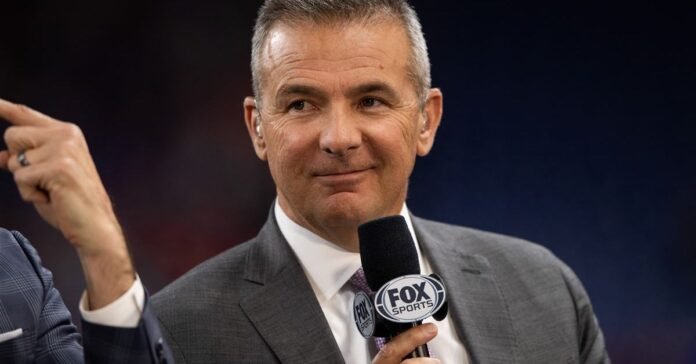Urban Meyer spent many years deeply involved in college football. His head coaching career at Bowling Green, Utah, Florida and Ohio State helped him rise to the top of the sport as a three-time national champion.
After a brief stint in the NFL, Meyer is now retired from coaching but still stays connected to college football. He works as an analyst for FOX, including as one of the hosts on the Big Noon Kickoff pre-game show.
While he may not be in the coaching office every day or on the field with the players like he once was, Meyer stays connected to the sport. He follows the game closely and, like any fan, has his opinions.
Recently, Meyer sat down with 10TV’s Dom Tiberi to discuss the state of college athletics and the recent House settlement that has taken effect.
Follow Patrick Murphy on Twitter and Instagram for more Ohio State coverage
What’s next for the Buckeyes? Make sure you’re in the loop — take five seconds to sign up for our FREE Buckeyes newsletter now!
“I’ve always been a proponent that, in America, name and likeness should be something that is a way of life. I’m a capitalist,” Meyer said. “There was far too many restrictions. I get it, why, because everybody’s pushing that envelope, but I think it’s the right thing.”
In June 2025, U.S. District Judge Claudia Wilken approved a historic settlement resolving three antitrust lawsuits against the NCAA and Power Five conferences, including House v. the NCAA. Among other things, this decision marked the start of the revenue-sharing era in college athletics.
While student-athletes could earn money off their name, image and likeness since 2021, they were paid by third parties. This ruling now allows schools and athletic departments to pay student-athletes directly by sharing up to $20.5 million in revenue.
“I’m anxious to see how they do this,” Meyer said. “You got some schools like, say a Duke and a North Carolina, that are really basketball-heavy schools. How are they going to distribute this money?
Ohio State decided to divide $18 million among four sports – football, men’s basketball, women’s basketball and women’s volleyball – while allocating 91 new scholarships for other sports from the remaining revenue-sharing funds.
Besides revenue sharing, the House settlement allowed collectives to become part of the athletic departments. These collectives formed near programs across the country as a way for outside groups to raise money to pay players. The funds raised now help athletic departments raise the $20.5 million cap set by revenue sharing. However, all third-party deals over $600 must be audited for fair market value by the Deloitte-managed “NIL Go” clearinghouse, a topic on its own that is also controversial.
This is all overseen by a new College Sports Commission, the enforcement group responsible for making the final decisions on punishments and determining rule violations related to payments to players.
Meyer is uncertain whether this is the right way to proceed.
“I’m not a big fan of how we got to this spot,” he said. “I’m not a big fan of the collectives that raised – I just hear these stories, and I don’t think that’s going away. I was kind of misled, thinking that this new college football commission is going to have subpoena power, and they’re going to have an independent college football commission that’s going to regulate, enforce and assess penalties. The more I’m hearing, it’s going to be just the same as it was because there is no subpoena power unless you involve the federal government and the state government. So I’m skeptical about that.”
Although winning was important to Meyer throughout his coaching career, he was also a strong supporter of preparing student-athletes for life after sports. He helped establish Real Life Wednesdays at Ohio State, a weekly program where guests from various industries would come speak to the Buckeye football team about skills that will help them in the real world. This allowed players to build connections outside of football and gain a better understanding of what they will need to succeed off the field.
Meyer worries that this new revenue-sharing era will prioritize paying players while they’re in school over helping them manage their lives afterward.
“I hate to be that old guy that looks back. I just still believe that college football is about representing your university and getting an incredible degree and then living life once you’re done,” Meyer said. “And for a very small few, you make enough money to maybe not ever have to work again. So I’ve always approached it, we get these players for three years, sometimes four, we have to do everything (we can for them).
DONATE TO ‘THE FOUNDATION’: Click here now to assist with Name, Image and Likeness compensation for Ohio State football and basketball student-athletes.
“Majority of college football players don’t play in the NFL and it’s not a career. So these young people are going to have 40 years, 45 years to go to work someday and support their families. And that’s to me, is the ultimate mission of a coach and a university.”
While he is concerned about certain aspects of college football’s direction, Meyer also sees the sport’s positives. As a FOX analyst, he’s as engaged with the sport nationwide as he’s ever been and appreciates what he observes from the on-field game.
“It’s maybe never been better,” Meyer said. “I think the coaching is tremendous. The players are tremendous. I just worry about that kid that comes from a tough background and his dream is to play in the NFL and it doesn’t happen. Is he prepared to go out and get a job and support his family for the next 40, 43 years? And if not, the university failed him.”


























